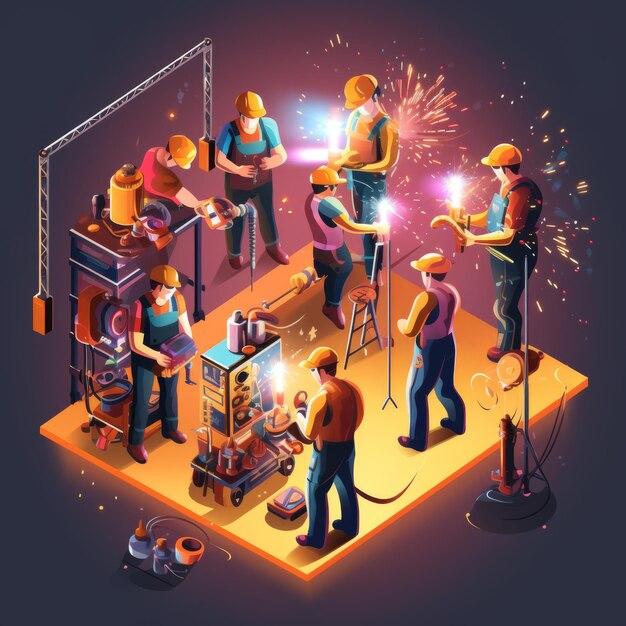
by denieljulian79 | Jul 25, 2025 | Education
Running a food manufacturing business is no walk in the park. You’re churning out products—maybe crispy snacks, creamy yogurts, or savory sauces—while keeping an eye on quality, costs, and deadlines. But here’s the thing: one tiny slip-up in food safety can bring it all crashing down. That’s where HACCP training comes in. Hazard Analysis and Critical Control Points (HACCP) isn’t just a regulatory hurdle; it’s your playbook for keeping your products safe, your customers happy, and your business booming. Let’s dig into why HACCP training is a must for anyone in food manufacturing.

What’s HACCP, and Why’s It a Big Deal?
HACCP stands for Hazard Analysis and Critical Control Points. It’s a system that helps you spot and control risks—like bacteria, chemicals, or bits of metal—that could make your food unsafe. Think of it like a fire alarm for your production line: it warns you about dangers before they spark a crisis. HACCP training teaches you how to build this system, step by step, so you’re not just reacting to problems but preventing them.
This isn’t just for corporate giants like General Mills or Tyson Foods. Whether you’re a small-batch granola maker or a large-scale cannery, HACCP training is your ticket to staying legit and safe. Without it, you’re gambling with your reputation—and nobody wants to roll the dice on that.
Who in Food Manufacturing Needs HACCP Training?
If you’re in food manufacturing, HACCP training is pretty much non-negotiable. The FDA and USDA mandate HACCP plans for industries like meat, poultry, seafood, and juices, but even if you’re not under their thumb, it’s a smart move. Here’s who needs to get on board:
-
Plant Managers: You’re overseeing the whole operation, so you need to know how to keep safety first.
-
Production Supervisors: If you’re managing the line, HACCP training helps you spot risks in real-time.
-
Quality Control Teams: QA folks use HACCP to ensure every batch meets safety standards.
-
Small Manufacturers: Crafting artisanal pickles or vegan cheese? HACCP keeps you compliant and credible.
I heard about a small salsa company that skipped HACCP training, thinking their “natural” process was enough. Then a batch got recalled for E. coli, and they lost their biggest distributor. Ouch. HACCP training could’ve saved them a world of hurt.
Why HACCP Training Is Your Secret Sauce
You might be wondering, “Okay, HACCP training sounds important, but what’s the real payoff?” Honestly, it’s like having a superpower in an industry where mistakes can be catastrophic. Let’s break down why it’s such a game-changer for food manufacturing.
Keeping Your Products Safe and Sound
Nobody wants their food to make someone sick. HACCP training teaches you to map out your process—from raw ingredients to finished goods—and identify “critical control points” where things could go wrong. Is your soup heated enough to kill pathogens? Are your nuts stored to avoid mold? HACCP helps you nail these details, so your customers can enjoy your products without worry.
Dodging the Recall Bullet
Recalls are a manufacturer’s worst nightmare. Just look at the 2018 romaine lettuce E. coli outbreak—millions in losses and a PR disaster that shook the industry. HACCP training helps you catch risks early, like cross-contamination or improper cooling, so you don’t end up with a truckload of tainted product. It’s like having a crystal ball to see trouble coming.
Making Regulators and Retailers Happy
The FDA loves HACCP because it shows you’re serious about safety. A solid HACCP plan makes inspections a breeze and keeps warning letters at bay. Plus, big retailers like Costco or Target won’t even look at you without HACCP compliance. Training gives you the tools to win their trust and get your products on shelves. Who doesn’t want that kind of access?
Building a Safety-First Culture
HACCP training isn’t just for managers; it’s for your whole team. It gets everyone—from line workers to warehouse staff—thinking about safety. I visited a snack factory once where every employee could recite their HACCP checkpoints. That kind of teamwork caught a packaging error before it shipped, saving them thousands. That’s the magic of a trained crew.
How HACCP Training Works: No Rocket Science Here
Feeling intimidated? Don’t be. HACCP training is designed to be practical, not some ivory-tower lecture. Here’s what you can expect:
-
Get the Basics: You’ll learn the seven HACCP principles, like spotting hazards and setting limits. Online courses from the International HACCP Alliance are a solid starting point.
-
Analyze Your Process: Training shows you how to break down your production line and find risks—like allergen cross-contact or improper storage.
-
Craft Your Plan: You’ll build a HACCP plan tailored to your facility, with steps for monitoring and fixing issues.
-
Put It to Work: Roll out your plan and train your team to follow it. Software like FoodLogiQ or SafetyChain can keep your records organized.
-
Earn Your Stripes: Many programs offer certification, which looks great to regulators and boosts your cred.
Pro tip: Check out providers like NSF International or Food Safety Plus for training. They offer online, in-person, or hybrid options, so you can learn at your own pace. It’s like picking the right knife for a recipe—find what fits your needs.
The Cost of Skipping HACCP Training
Let’s flip the script for a second. What happens if you think, “I’ll wing it”? Bad call. Skipping HACCP training is like driving without headlights at night—you might be fine for a bit, but you’re asking for trouble. Here’s what you’re risking:
-
Regulatory Heat: The FDA or USDA can hit you with fines, product seizures, or even a shutdown. That’s a gut-punch to your bottom line.
-
Recalls and Lawsuits: One bad batch can trigger a recall, lawsuits, or worse—public health harm. The 2011 Jensen Farms listeria outbreak? It cost lives and millions.
-
Reputation Damage: A single X post about contaminated food can sink your brand. Consumers don’t forgive food safety flops.
-
Lost Opportunities: Without HACCP, you’re locked out of major retailers and distributors. That’s revenue left on the table.
I saw a thread on X about a small bakery that ignored HACCP and got nailed for moldy bread. They lost their local grocery contract and haven’t recovered. Don’t let that be your story.
Beyond HACCP: The Bigger Food Safety Picture
HACCP training is your cornerstone, but food manufacturing safety has a few more layers. Here’s what else to keep on your radar:
-
FSMA Rules: The Food Safety Modernization Act (FSMA) adds preventive controls on top of HACCP. Training often covers both, so you’re fully compliant.
-
Labeling and Allergens: With allergies spiking, you need to manage cross-contact risks. HACCP training helps you set up controls to keep labels accurate.
-
Audits and Records: Regulators love paperwork. Tools like TraceGains or FoodDocs make it easier to stay audit-ready.
Quick sidetrack: I once toured a sauce plant where their HACCP plan was like a well-oiled machine—every step documented, every risk covered. The manager said, “It’s like running a kitchen for a thousand picky eaters.” That stuck with me. HACCP training brings that kind of precision to your operation.
Summer 2025: Why HACCP Training Is Hot Right Now
As we head into summer 2025, food manufacturing is buzzing with trends—think spicy condiments, plant-based proteins, and functional drinks. But new products mean new risks, and the FDA’s watching closely, especially for allergen issues and contamination. HACCP training keeps you ready to tackle these challenges and stay ahead of the curve.
Plus, with holiday season planning in full swing, retailers are picking their suppliers now. A HACCP-trained operation shows you’re reliable, whether you’re pitching to Whole Foods or a regional chain. It’s like having a front-row seat in a crowded market.
Your Next Move: Get HACCP Training and Shine
So, what’s the plan? If you haven’t done HACCP training, sign up today. Look into providers like NSF, Food Safety Plus, or online platforms like Udemy for flexible courses. If you’re already trained, consider a refresher or train your team to spread the knowledge. Tools like Safefood 360° can help you manage your HACCP plan like a pro.
HACCP training isn’t just a box to check; it’s your foundation for success in food manufacturing. It’s about keeping your products safe, your business strong, and your customers coming back for more. So, why wait? Get trained, build your plan, and keep making food that’s as safe as it is delicious.

by denieljulian79 | Jun 25, 2025 | Education
Ever lie awake at night worrying about someone getting hurt on the job? If you’re striving for a zero-accident culture, that fear is all too real. One slip—a misplaced tool, a skipped safety check—and you’re dealing with injuries, downtime, or worse, a hit to your team’s morale. So, how do you make sure your workplace is a safe haven where accidents are a thing of the past? That’s where ISO 45001 certification comes in. It’s not just a certificate to hang on the wall; it’s a blueprint for building a workplace where everyone goes home safe. Let’s unpack why ISO 45001 certification is your secret weapon for a zero-accident culture and how it can transform your safety game.

What’s ISO 45001 Certification, Anyway?
Picture this: you’re trying to build a house that’s storm-proof. You could guess at the design, but wouldn’t you rather follow a plan that’s been tested worldwide? ISO 45001 certification is that plan for workplace safety. Developed by the International Organization for Standardization, it’s the global standard for occupational health and safety management systems. It’s a set of guidelines that helps you spot risks, prevent accidents, and create a culture where safety isn’t just a rule—it’s a way of life.
Getting certified means an independent auditor has given your safety practices a big thumbs-up. It’s like a badge that says, “We put people first.” For any team aiming for a zero-accident culture—whether in construction, manufacturing, or even an office—ISO 45001 certification proves you’re serious about keeping everyone safe. But why does it matter so much? Let’s dig in.
Why ISO 45001 Certification Is Key to a Zero-Accident Culture
Creating a zero-accident culture isn’t just about posting safety signs or handing out hard hats. It’s about building trust, preventing mishaps, and making sure everyone feels protected. ISO 45001 certification is your roadmap to getting there. Here’s why it’s a game-changer:
-
Builds Trust Across the Board: Employees want to know they’re safe, and clients—like contractors or regulators—want proof you’re reliable. ISO 45001 certification shows you’re not just talking about safety; you’re living it, making your workplace a magnet for talent and contracts.
-
Spots Risks Before They Strike: The certification process makes you map out every potential hazard, from faulty machinery to ergonomic issues. You’ll catch dangers you didn’t even know existed. One warehouse I know slashed their injury rate by 35% after implementing ISO 45001 guidelines. That’s fewer trips to the ER and happier workers.
-
Saves You Money: Accidents aren’t cheap—think medical bills, lost productivity, or fines. ISO 45001 certification helps you prevent incidents, saving you from those gut-punch costs.
-
Keeps You Compliant: Safety regulations, like OSHA or EU-OSHA, are strict. ISO 45001 aligns with many of these rules, helping you dodge penalties and pass inspections with ease.
Sounds like a win, right? But here’s the thing: getting certified takes work. It’s not something you can slap together in a day. Is it worth the effort? Let’s talk about that next.
The Cost of ISO 45001 Certification (And Why It’s a No-Brainer)
Let’s be real: ISO 45001 certification comes with a price tag. You’re looking at costs for consultants, audits, training, and maybe software like Cority or Intelex to track safety data. For a small business, that can feel like a heavy load. I once talked to a safety supervisor in Georgia who nearly backed out because the upfront costs seemed daunting. A year later? He said, “It was the best decision we ever made.”
Why? Because the benefits are massive. His company cut workplace incidents by 30%, boosting morale and slashing workers’ comp costs. Plus, they won a major contract with a construction firm because they could show off their ISO 45001 certificate. The deal was worth four times what they spent on certification. That’s not just a win—it’s a slam dunk.
Here’s a tip: you don’t have to do it all at once. Start with the basics of ISO 45001, like identifying hazards and setting up a safety system. Once you’ve got that down, you can build on it. It’s like training for a marathon—you start with short runs before going the full distance.
A Quick Side Note: It’s About Your People
You know what? ISO 45001 certification isn’t just about rules or audits. It’s about your team—the folks who show up every day, whether they’re welding steel or answering phones. Getting certified means training them to spot risks, like a loose scaffold or a cluttered walkway, and giving them the tools to stay safe. I’ve seen teams go from “safety’s just a checklist” to everyone watching each other’s backs after certification. Why? Because they know they’re part of a culture that puts their well-being first.
And let’s not forget your clients or regulators. In a world where safety incidents make headlines, ISO 45001 certification is like a firm handshake. It says, “We’ve got safety covered.” That’s huge when you’re bidding for contracts or facing a regulatory inspection.
How ISO 45001 Fits Into the Zero-Accident Culture of 2025
Let’s zoom out for a moment. Building a zero-accident culture is tougher than ever. With hybrid work, global supply chains, and new tech like robotics, risks are evolving fast—think mental health stress or equipment malfunctions. ISO 45001 certification is like a GPS for navigating this landscape. Its risk-based approach helps you stay ahead of hazards, whether it’s a physical danger or a psychological one.
And here’s something else: safety is a competitive edge in 2025. With economic uncertainty still in the air, clients and employees are pickier about who they work with. ISO 45001 certification sets you apart, especially in high-risk industries like construction or manufacturing. Plus, with trends like workplace wellness and mental health awareness gaining steam, ISO 45001’s holistic approach—covering both physical and mental safety—keeps you in tune with what matters.
Oh, and have you seen how many companies are flaunting their ISO 45001 certification at trade shows or on social media? It’s not just showing off. It’s a signal to everyone that you’re serious about safety in a world where one accident can derail your reputation.
Getting Practical: How to Get ISO 45001 Certified
Alright, let’s get down to brass tacks. You’re sold on ISO 45001 certification, but how do you make it happen? It’s not like you can wave a wand and get certified. Here’s a straightforward plan to get you started:
-
Understand the Standard: Check out resources from BSI or the ISO website to get a handle on ISO 45001’s requirements. It’s all about building a safety management system.
-
Assess Your Risks: Use tools like Intelex or hire a consultant to identify hazards—think unguarded equipment or inadequate training. This is your reality check.
-
Rally Your Team: Safety isn’t just for managers. Train everyone—workers, supervisors, everyone—to follow protocols and report risks.
-
Document Everything: ISO loves records (sorry, it’s true). Create policies, procedures, and logs to prove you’re doing things right.
-
Pass the Audit: An external auditor (like SGS or TÜV SÜD) will review your system. Ace it, and you’re certified. If not, fix the gaps and try again.
Word of advice: don’t skimp on the consultant. A good one can make the process smoother and faster. And if costs are a worry, check for grants—some governments offer funding for businesses pursuing ISO 45001 certification. Worth a quick Google, don’t you think?
What If You Skip ISO 45001 Certification?
Here’s something to chew on: what’s the risk of passing on ISO 45001 certification? Sure, you save some cash upfront, but you might be setting yourself up for trouble. Without certification, you’re less likely to win contracts with clients who prioritize safety, like major contractors or government agencies. Your competitors with ISO 45001 badges will look like the safer choice, even if your practices are just as good. And if an accident happens, you’ll have a harder time proving your safety processes are solid.
I heard about a manufacturing plant in Texas that lost a multi-million-dollar contract because they lacked ISO 45001 certification. The client didn’t even give them a second look. That’s the kind of missed opportunity that stings.
Wrapping It Up: Your Path to a Zero-Accident Culture with ISO 45001
So, where does this leave you? ISO 45001 certification isn’t just a shiny badge—it’s a way to build a zero-accident culture that keeps your team safe, your clients happy, and your business thriving. It fosters trust, prevents incidents, and opens doors to new opportunities. Yes, it takes effort. Yes, it costs money. But the payoff? It’s like upgrading from a flimsy safety net to a steel-reinforced one—everyone feels more secure.
If you’re ready to take the leap, start small. Talk to your team, research consultants, and maybe even chat with a certified colleague in your industry. The road to ISO 45001 certification might seem long, but every step gets you closer to a workplace where accidents are history. So, what’s holding you back? Isn’t it time to make safety your superpower?


